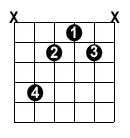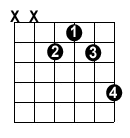CAGED: HOME | Getting_Started | Chords | Scales | Arpeggios Minor_Chords | Minor_Scale_Shapes | Minor_Arpeggio_Shapes | More_CAGED
C Minor Barred

Fret/Chord Chart
You can determine the name of the chord when the root (lowest) note is played on the frets in the chart below.
| Fret | 1 | 2 | 3 | 4 | 5 | 6 | 7 | 8 | 9 | 10 | 11 | 12 | 13 | 14 |
| Minor Chord | – | – | C Open | C#/Db | D | D#/Eb | E | F | F#/Gb | G | G#/Ab | A | A#/Bb | B |
Alternate Fingering
You may want to try the alternate fingering below for
the barred form. It’s a lot easier to play. It omits the
root note which might sound a little different at first,
but it’s still a C minor chord. This is called an inversion.
You’ll learn more about inversions when you get to dominant
7th chords. When you are fretting it imagine an invisible
finger fretting the root note on the 5th or you may get
in a bad habit of using the note on the 4th fret to name
the chord, which would be wrong.

Exercise
A great way to master the fingering for the C minor style
barre is to play it on the 4th fret, then 2nd, and so on.
Continue up the fret board all the way up to the 12th fret.
Then go all the way back down to the open position. It’s
a bit tough at first, but with practice you’ll get it!
The exercise is performed in the audio example below using
the alternate fingering.